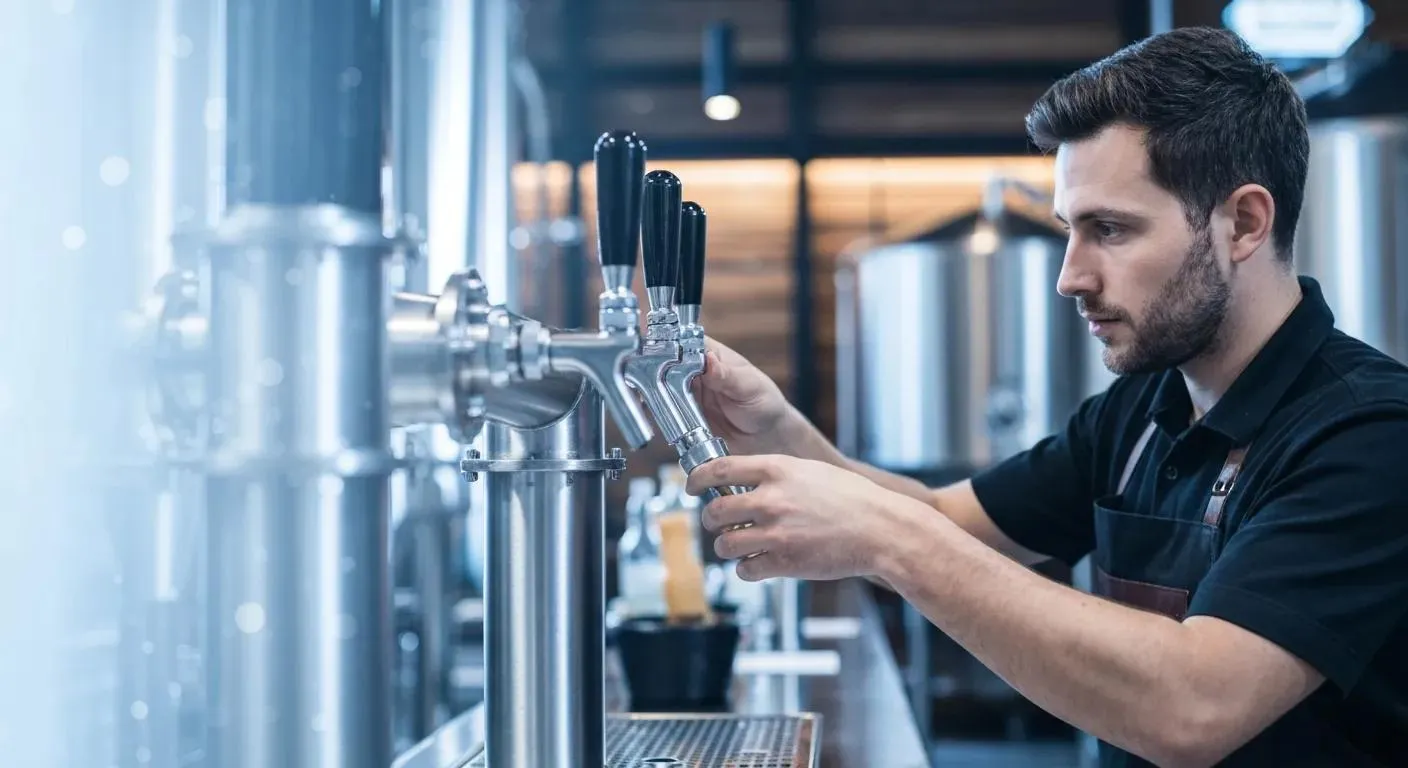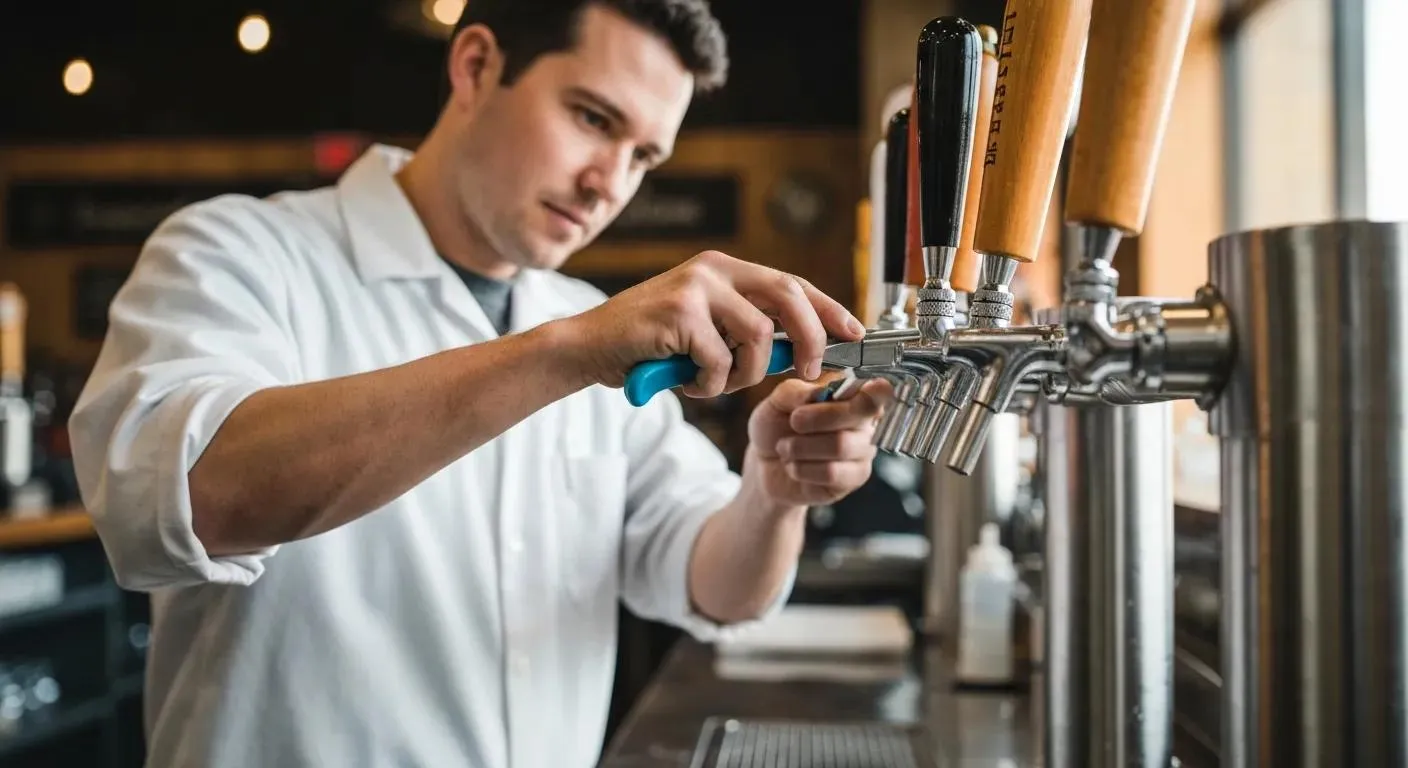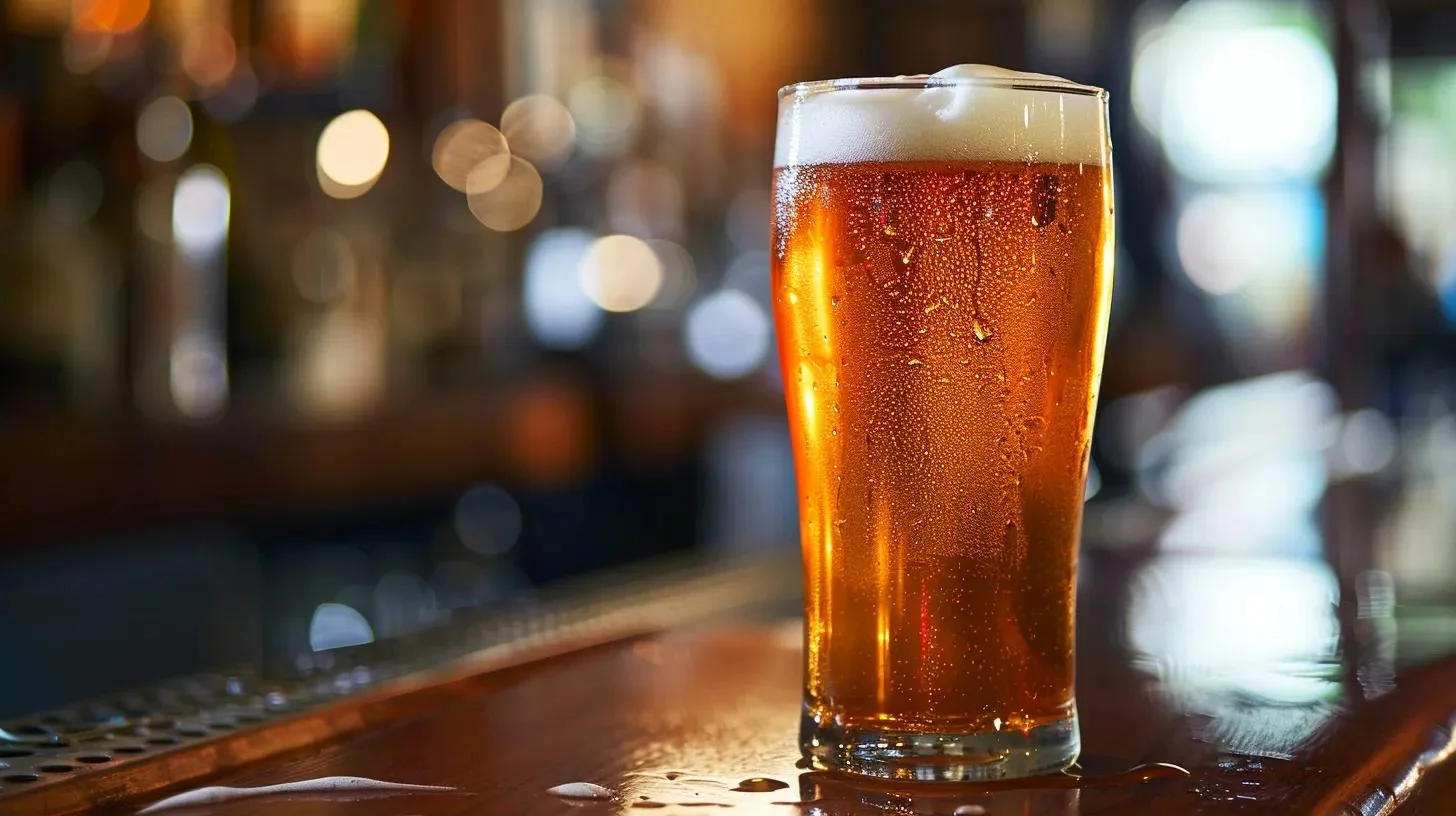Keg Cooler with Tap: The Essential Guide for Chilled Beverages

Keg coolers with taps, often referred to as kegerators, are a popular choice among beer and wine enthusiasts. These specialized refrigeration units are designed to hold beer kegs at the perfect temperature. This ensures a fresh and crisp taste with every pour.
Not only do these coolers provide convenience and savings over time by eliminating the need for individual beer purchases, and wine bottles, but they also add a professional touch to home bars and entertainment spaces.
Selecting an appropriate keg cooler for one's home involves understanding various factors. The type of keg cooler, capacity, temperature control, pressure settings, and even the unit's aesthetic design are key considerations.
Moreover, some coolers offer additional features such as dual taps for dispensing different types of beer or built-in drip trays for easy cleanup. Proper installation and regular maintenance are crucial to the longevity and performance of the keg cooler.

Key Takeaways
- Keg coolers with taps enhance at-home beer drinking with freshness and convenience.
- Features such as temperature control and design vary, affecting overall satisfaction.
- Installation, maintenance, and proper setup are essential for optimal cooler performance.
Understanding Keg Coolers
A keg cooler, often referred to as a kegerator, is an essential appliance that maintains kegs at an optimal temperature while allowing beer to be dispensed through a tap. This section breaks down the critical components of a keg cooler and elucidates how they function together to deliver a crisp, refreshing draft beer.
Components of a Keg Cooler
- Tap: The faucet through which beer is dispensed.
- Pressure Regulation: Involves a CO2 tank and a CO2 regulator to control the flow and pressure of CO2 gas into the keg, maintaining carbonation and pushing beer through the tap.
- Temperature Control: A keg cooler operates within a specific temperature range (typically between 36-40°F) to ensure the beer stays cold without freezing.
- Keg Coupler: This device attaches to the keg valve, creating a seal that allows CO2 in and beer out.
- Stainless Steel Keg: Commonly utilized by commercial dispensing systems. Typically 1/4 Barrels, 1/6 barrels, and 1/2 barrels.
How Keg Coolers Work
A keg cooler is a system designed to keep beer fresh, carbonated, and ready to pour. At the heart of this system is the CO2 tank, which, through a CO2 regulator, maintains the proper pressure for both pushing the cold beer out of the keg and keeping it carbonated.
To ensure consistent quality, the temperature inside the keg cooler must be carefully managed. This often requires specific ventilation requirements to prevent overheating of the unit.
The keg coupler plays a critical role in connecting the keg to the beer line without any kink in the line, which could disrupt beer flow or quality. When serving, a smooth pull on the tap dispenses the beer, with the chrome guard rail providing an additional level of safety and functionality.
Types of Keg Coolers
When selecting a keg cooler with tap, commonly referred to as a kegerator, one must consider the different types available. Options range from freestanding or built-in units to variations like mini-fridge kegerators and full-sized models with dual tap capabilities.
Freestanding vs. Built-in Units
Freestanding kegerators are versatile and can be placed in various locations, often featuring rolling casters for easy mobility. They require ventilation space around them for proper airflow.

On the other hand, built-in kegerators are designed to be integrated into cabinetry, offering a seamless look in a home bar or kitchen. Both types can be crafted with stainless steel for durability and aesthetic appeal.
Mini-Fridge Kegerators
Mini-fridge kegerators are compact, typically designed to hold a single mini keg, and are an excellent choice for those with limited space. Despite their size, many are equipped with high-performance features and provide a convenient and portable way to enjoy draft beer. They are often seen as an entry-level option for casual beer enthusiasts.
Full Size and Dual Tap Options
For those who entertain frequently or appreciate variety, full size kegerators are ideal. These can accommodate larger kegs or multiple kegs simultaneously.

Dual tap kegerators allow for dispensing two different types of beer, offering more variety for guests. Full-sized models can also include additional features like digital temperature displays and adjustable shelving.

Temperature and Pressure Control
Achieving the right balance of temperature and pressure is crucial for pouring the perfect pint of draft beer. This balance ensures that the beer maintains its intended flavor profile and carbonation level from keg to glass.
Importance of Maintaining Temperature
Temperature control is pivotal in dispensing draft beer because it directly affects the beer's carbonation and taste. Most kegerators feature mechanical temperature controls that allow users to set the internal temperature, usually between 34-42 degrees Fahrenheit to maintain optimal beer quality.
Insufficient cooling can lead to warm, foamy beer, while excessive cold can mute flavors and increase carbonation solubility, leading to flat beer when it warms.

Regulating Pressure
Regulating pressure is equally important, which is where tools like a single gauge regulator come into play. They measure the pounds per square inch (PSI) of pressure being applied to the keg.
The desired pressure varies depending on the type of beer but typically ranges from 10 to 12 PSI. Consistent pressure keeps the beer carbonated and prevents it from becoming either too foamy or flat.

Tools for Monitoring and Control
Several tools are essential for monitoring and maintaining temperature and pressure within a keg wine cooler and system:
- Mechanical Temperature Control: This dial or digital interface allows for precise setting and monitoring of the internal temperature.
- Single Gauge Regulator: Attached to the CO2 tank, it displays the PSI and helps maintain the correct carbonation level.
- Draft Beer Tower: Often insulated to maintain the coolness of the beer as it travels from the keg to the glass.
- Cooling Power: It is the capacity of the kegerator to remove heat within its chamber to maintain the set temperature. This factor is crucial in determining how well the system can sustain the desired temperature over time, especially in different ambient conditions.
Design and Aesthetics
The aesthetic design of a keg cooler with tap marries functionality with style. Prospective buyers should consider not just the performance, but also how the materials, finish, and dimensions will integrate into their space and decor.

Materials and Finish
Most high-quality keg coolers feature a stainless steel draft tower known for its durability and resistance to corrosion. This material is also praised for its sleek appearance, which fits seamlessly into a variety of decor schemes.
Another popular choice for the body is a spotless steel finish. It offers the professional look of stainless steel while providing a surface less prone to fingerprints and smudges.
Dimensions and Space Considerations
When choosing a keg cooler with tap, product dimensions are vital:
- Product Width: Standard models can vary significantly, with some compact designs as narrow as 10 inches.
- Product Depth: Depth is typically congruent with width to maintain balance, but can be deeper for larger capacities.
- Product Height: On average, keg coolers stand about 16 inches tall, but the height must be decided with the location in mind, especially if it's intended to fit under counters.
The cooler should also provide a scratch-resistant worktop, ensuring that it remains aesthetically pleasing despite frequent use. It is important to verify the size of the desired installation space against the product's dimensions to ensure a good fit, adherence to safety standards, and ease of use.
Additional Features and Accessories
When exploring options for a keg cooler with tap, one should consider the array of additional features and amenities designed to enhance functionality, such as drip trays for cleanliness or customizable shelving for versatility.
Drip Trays and Guards
Many keg coolers come equipped with drip trays that make maintaining the cleanliness of your draft service area effortless. They catch any spillage of cold draft beer, mitigating mess and waste.
Some models feature a chrome guard rail to prevent glasses from sliding off the machine's top surface, combining safety with convenience.

Customizable Shelving
Keg coolers often offer customizable shelves and shelving options, allowing for flexible storage of different sized kegs or other beverages. This adaptability is essential for businesses that need to maximize their use of space within the beer cooler.
Such shelving can typically be adjusted or removed as necessary to accommodate various keg sizes.
Hardware and Safety Features
A robust keg cooler might include an aluminum CO2 tank, which is essential for beer carbonation. Additionally, safety features like an R600a refrigerant signify a commitment to environmentally friendly practices and superior energy efficiency.
Some coolers boast an automatic defrost function, saving time on maintenance. The convenience of a reversible door hinge allows for flexibility in the placement of both the keg and cooler within any space.
Installation and Setup
Installing and setting up a keg cooler with tap involves meticulous preparation, correct assembly of components, and understanding the start-up process.
Preparing for Installation
Before starting the installation process, you must ensure that all hardware components are present. Also, select an appropriate location for your keg cooler, which is designed primarily for indoor application.
Room temperature should be consistent, away from direct sunlight, and have access to an electrical outlet that supports the keg cooler's amps and wattage requirements.
Assembly of Components
When assembling a keg cooler, typically with a capacity of 5.4 cu. ft, one must follow the manufacturer's instructions carefully. Begin by installing the refrigerator without any wheels or casters for mobility, and then secure the tap tower on top of the cooler.
All connections should be double-checked to ensure that they are sealed and correctly fitted to prevent leaks or loss of pressure.
Starting Your Keg Cooler
After assembling the components, ensure the cooler is upright and plug it into an electrical outlet that meets the MSRP (Manufacturer's Suggested Retail Price) guidelines on power consumption. This is usually measured in amps and wattage.
Prepare the keg by setting it inside the cooler, connecting the CO2 tank, and attaching the tap. Now, the keg cooler is ready to chill the keg to the desired temperature before serving.
Maintenance and Care
Proper maintenance and care of a keg cooler with tap are essential for ensuring the longevity of the unit and the freshness of the beer it serves. This involves routine cleaning and hygiene practices, as well as periodic checks and servicing.
Portability features, such as optional swivel casters, may necessitate additional attention to maintain maneuverability. In-home service under a 12-month warranty can provide peace of mind for parts and labor costs.
Cleaning and Hygiene
- Beer Lines: Clean every two weeks or after each keg using a quality beer line cleaner to prevent bacterial buildup and off-tastes.
- Tap and Faucet: Disassemble and soak in a cleaning solution; scrub with a brush and rinse thoroughly.
- Keg Coupler: Disassemble and clean with sanitizer after each keg change.
- Drip Tray: Remove and wash regularly with soapy water; dry before replacing.
Routine Checks and Servicing
- Seals and Gaskets: Check for wear and replace as needed to prevent air and temperature leaks.
- Temperature Control: Monitor and adjust to ensure the beer is stored at optimal temperatures.
- CO2 Tank and Regulator: Inspect for leaks and ensure accurate pressure is maintained; refill the CO2 tank when low.
- Castors (if applicable): Lubricate swivel casters for continued portability and check for any damage that hinders movement.
- Warranty Service: Utilize the 12-month warranty for professional in-home service to address any complex issues or parts that may require expert attention.
Location and Placement
When selecting a location for a keg cooler with tap, one must consider the environment and the practicality of the setup. The space should accommodate the cooler size, allow for proper ventilation, and align with whether the unit will be used indoors or outdoors.
Outdoor vs. Indoor Use
Outdoor Use: For outdoor gatherings such as BBQs or pool parties, choose a keg cooler like the Kegco Outdoor Dual Tap that features a durable stainless steel exterior suitable for varied weather conditions.
Portability is a factor here; if frequent movement is anticipated, consider a unit with a lighter package weight and package dimensions that can be tucked neatly in a corner of your patio or deck.
Indoor Use: Indoors, a keg cooler can be the centerpiece in a wet bar, game room, or man cave. Brands like EdgeStar and Danby offer models designed to fit seamlessly with home decor.
EdgeStar's low temperature dual single tap kegerator that could be ideal for serving draft beer through American Sankey couplers.
Ensure there's enough clearance around the beer dispenser for heat emission, especially if it's built into cabinetry.
Space Layout and Ventilation
Space Layout: Determining the configuration of the area where the keg cooler will be placed is essential. For compact areas, consider the dimensions and whether the unit is front-venting, critical for built-in spaces like under a wet bar.
An organized space layout can prevent clutter and maintain accessibility for keg changes and maintenance.
Ventilation: A keg cooler's performance is heavily reliant on proper ventilation to prevent overheating.
Standard wattage appliances emanate a certain amount of heat that needs to dissipate correctly.
Ensure there's a gap of at least 1-2 inches around the cooler’s venting sides to maintain optimal operation and prolong the lifespan of the cooler.
Summary
In summary, keg coolers with taps, or kegerators, offer an advanced and efficient solution for beer enthusiasts looking to enhance their home or commercial beverage serving capabilities. These units not only keep beer at the ideal serving temperature but also incorporate CO2 systems to ensure the beer remains carbonated and fresh. With options ranging from compact, portable models to full-sized, dual-tap kegerators, there's a keg cooler to fit every space and need. Whether for personal use in a home bar or for commercial purposes, a keg cooler with a tap provides a professional beer dispensing experience, combining convenience, efficiency, and style. The choice of a keg cooler ultimately depends on individual preferences, space considerations, and budget, but the benefits of having fresh, perfectly chilled beer on tap are undeniable.
Key Features of a Keg Cooler with Tap:
- Temperature Control: Ensures beer is served at the perfect temperature.
- CO2 System: Carbonates beer and maintains its effervescent quality.
- Multiple Tap Options: From a single tap system to multiple taps for serving various beers.
- Capacity: Ranging from smaller kegs to 1/2 barrels.
For more questions about commercial kegerators please reach out to us at Renny's.



